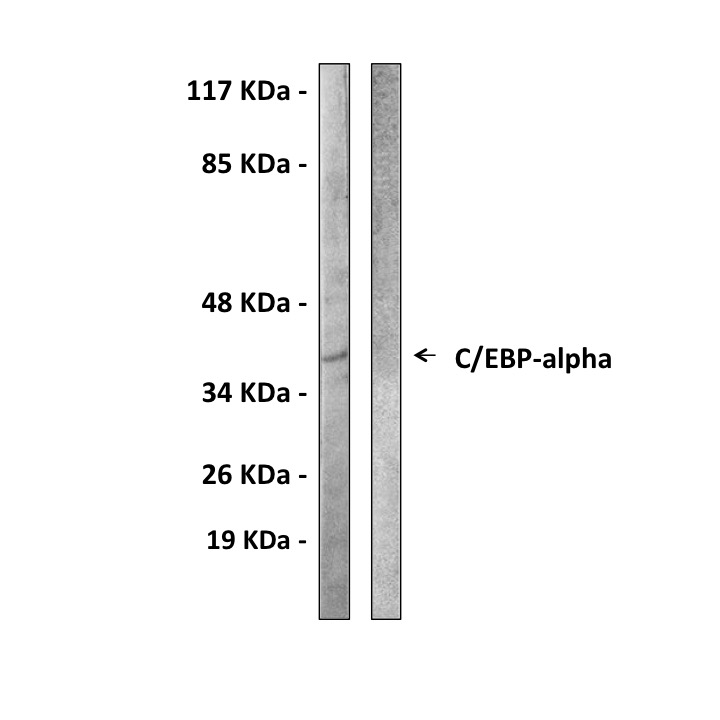Product Sheet CG1054
Description
BACKGROUND C/EBPalpha is the prototypical basic-region leucine zipper (bZIP) transcription factor. This family is characterized by the presence of a basic region that mediates DNA binding and a leucine zipper that allows dimer formation. In addition to forming homodimers, C/EBPalpha dimerizes with other members of the C/EBP family (C/EBPbeta, -gamma, -delta, episilon, and CHOP) and interacts with other proteins such as TFIIB, TBP, Rb, p300/CBP, p21, and members of the SWI/SNF complex.1 C/EBPalpha mRNA can be translated from the first AUG encoding the 42-kDa normal isoform and also from the second AUG (nt 508–510) encoding the 30-kDa normal isoform. The functions of C/EBPalpha 30-kDa protein are not well known. It was suggested that this shorter C/EBPalpha protein had lost normal C/EBPalpha functions and had dominant negative effect on 42-kDa wild-type (wt) C/EBPalpha. Recently, it has been shown that C/EBPalpha is regulated by phosphorylation and sumoylation.2
A key role of C/EBPalpha is to regulate differentiation of a select set of cell types. It acts as a transcription factor with a crucial role during differentiation of various cell types including hepatocytes, adipocytes, enterocytes, keratinocytes, lung, mammary gland cells and hematopoietic cells.3 Several recent studies highlight the crucial antimitotic role of C/EBPalpha, which inhibits cell growth through a variety of mechanisms. First, C/EBPalpha induces expression and stability of the cyclin-dependent kinase inhibitor, p21/WAF1. Second, C/EBPalpha interacts directly with the cyclin-dependent kinases Cdk2 and Cdk4 and blocks their ability to interact with cyclins, thereby impeding cell cycle progression. Finally, C/EBPalpha directly represses the activity of E2F, a key transcriptional regulator of cell cycle genes.4
REFERENCES
1. Darlington, G.J. et al: J. Biol. Chem. 273:30057-60, 1998
2. Ross, S.E. et al: Mol. Cell. Biol. 24:675-86, 2004
3. Lekstrome-Himes, J & Xanthopoulus, K.G.: J. Biol. Chem. 273:28545-48, 1998
4. Timchenko, N.A. et al: Gene Dev. 10:804-15, 1996
2. Ross, S.E. et al: Mol. Cell. Biol. 24:675-86, 2004
3. Lekstrome-Himes, J & Xanthopoulus, K.G.: J. Biol. Chem. 273:28545-48, 1998
4. Timchenko, N.A. et al: Gene Dev. 10:804-15, 1996
Products are for research use only. They are not intended for human, animal, or diagnostic applications.

(Click to Enlarge) Immunoblotting analysis of extracts from COS7 cells, treated with EGF 200ng/ml 30′, using Anti-C/EBP-α antibody. The lane on the left was treated with the Anti-C/EBP-α antibody. The lane on the right (negative control) was treated with both Anti-C/EBP-α antibody and the synthesized immunogen peptide.
Details
Cat.No.: | CG1054 |
Antigen: | Synthesized peptide derived from human C/EBP-α protein. |
Isotype: | Rabbit IgG |
Species & predicted species cross- reactivity ( ): | Mouse, Human, Rat |
Applications & Suggested starting dilutions:* | WB 1:500-1:1000 IP n/d IHC n/d ICC n/d FACS n/d ELISA 1:1000 |
Predicted Molecular Weight of protein: | 37 KDa |
Specificity/Sensitivity: | Detects endogenous C/EBP-alpha proteins without cross reactivity with other family members. |
Storage: | Store at -20°C, 4°C for frequent use. Avoid repeated freeze-thaw cycles. |
*Optimal working dilutions must be determined by end user.
Products
| Product | Size | CAT.# | Price | Quantity |
|---|---|---|---|---|
| Rabbit C/EBP-Alpha Antibody: Rabbit C/EBP-alpha Antibody | Size: 100 ul | CAT.#: CG1054 | Price: $384.00 |
